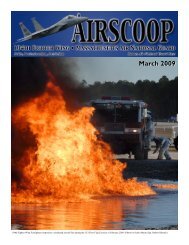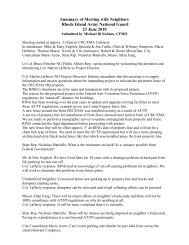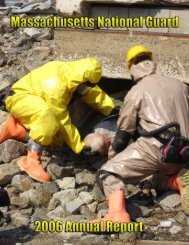Appendix K - Tungsten Information - STATES
Appendix K - Tungsten Information - STATES
Appendix K - Tungsten Information - STATES
You also want an ePaper? Increase the reach of your titles
YUMPU automatically turns print PDFs into web optimized ePapers that Google loves.
56<br />
CONCLUSIONS<br />
ERDC/CRREL TR-07 -xx<br />
<strong>Tungsten</strong> is present in the surface soils of three small arms ranges at Camp Edwards. The level<br />
of tungsten in subsurface soils (generally less than 1 mg/kg) is significantly less than surface<br />
soils and decreases with depth. Soil pore-water in the unsaturated zone beneath the bullet<br />
pockets and trough areas has tungsten at levels that appear to correspond to the surface soil<br />
concentrations and range usage. <strong>Tungsten</strong> is present in one monitoring well located<br />
downgradient of the berm on B Range. Field and laboratory results indicate that the tungsten<br />
from the tungsten/nylon bullets is rapidly dissolved with solubility levels approaching several<br />
hundred mg/L. As tungsten metal is insoluble, we hypothesize that the small particles of<br />
tungsten in the bullets have oxidized and that we are dissolving tungsten oxides. Relatively high<br />
levels of tungsten (up to 400 mg/L) in the unsaturated zone pore water at depths up to 65 cm<br />
indicates tungsten is mobile through these sandy, acidic, aerobic soils. The presence of<br />
tungsten in groundwater at Camp Edwards indicates relatively rapid migration through the<br />
unsaturated zone. Results from nanopore sieving tests and HPLC GC tests suggest that the<br />
mobile form of tungsten is a tungstate anion, however, we cannot yet rule out a polytungstate<br />
form. Rapid migration indicates that the tungsten carried in the pore water is not retarded by<br />
sorption possibly because the clay content of Camp Edwards soils is low. Ground water impacts<br />
are possible for those installations with shallow depth to ground water and sandy soils. Surface<br />
water impacts are possible in temperate environments where surface water drains off the small<br />
arms range. Migration of tungsten from small arms ranges can be expected from sites with<br />
significant amounts of precipitation such as the Eastern United States or coastal regions of the<br />
Western United States with delayed impacts in arid environments.<br />
RECOMMENDATIONS<br />
As outlined in the Final Proposal Addressing <strong>Tungsten</strong> Fate and Transport at Camp Edwards<br />
dated May 25, 2006 additional studies are recommended to assess the fate and transport of<br />
tungsten at Camp Edwards. This additional work has been funded and will be focused on<br />
mapping the extent of tungsten in ground water at B Range, experimental work quantifying the<br />
dissolution rate and adsorption/desorption kinetics of tungsten on Camp Edwards soil,<br />
unsaturated and saturated zone modeling to assess the transport rates, and tungsten speciation<br />
studies to identify the aqueous form present in the environment.<br />
For the dissolution experiments, the next step is to standardize the experimental methods and<br />
run a series of tests using different soil:solution ratios. A test using aqueous sodium tungstate<br />
standard solution also is necessary to test whether tungsten is lost during sample preparation.<br />
One activity planned as part of the second phase of the tungsten study at Camp Edwards is to<br />
more rigorously establish the background level of tungsten in the soil pore-water and<br />
groundwater. We plan to install several additionallysimeters in remote locations to ascertain the<br />
background level of tungsten. In addition, we plan to sample up to a dozen additional<br />
background monitoring wells (to be identified in cooperation with the IAGWSP) to determine the<br />
natural background level of tungsten in the environment.
















